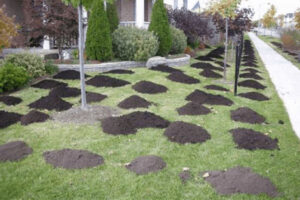After a long dreary northern Illinois winter, I’m sure you’re like most homeowners – anxious at the first sighting of a robin to get out into the yard and get to work. There are certainly a lot of spring yard projects that you can and should do, but fixing or renovating the lawn is actually best done in the fall. By late August through mid-September the summer’s heat and drought have passed. There is far less competition from lawn weeds for newly planted grass. Cooler day and nighttime temperatures, warm soil temperature and a bit more rainfall make this an ideal time to improve the lawn in preparation for the following season.
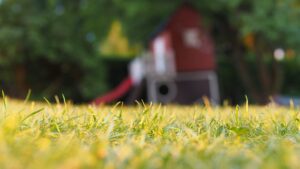 Do you have a problem with thatch?
Do you have a problem with thatch?
Before you start, take time to evaluate the overall condition of your lawn. Is there a layer of thatch that’s blocking water and nutrients from reaching the soil? Healthy lawns have less than ½ inch of thatch at dirt level. Thatch is merely dead grass that has not yet decomposed. Over time, the thatch layer breaks down and returns to the soil as organic matter which is then replaced by new thatch. This is a normal. But too much thatch means a thin, poor looking lawn.
To determine if the brown spots in the lawn and thin areas in your lawn are related to a thick thatch problem, remove a two inch deep wedge from your lawn. Measure the thatch or brown spongy layer between the soil surface and the green grass plants. If the layer is greater than 3/4 inch, you have too much thatch.
Dethatching a lawn with a high percentage bluegrass with a power rake is rarely the preferred option. It can be damaging to the grass because it pulls up individual grass plants by the roots, destroying much of the lawn in the process. Core aeration is a much better way to deal with excessive thatch. Lawns should be aerated once a year but not during hot, dry spells or when the soil is too wet. Early fall is an excellent time for this treatment.
Are any of these common problems present in your lawn?
![]() Has the grass turn “rusty” from fungus?
Has the grass turn “rusty” from fungus?- Are there indications of grubs in the lawn?
- Have trees matured and changed the sun/shade characteristics?
- Does the grass look thin and patchy?
- Are there an abundance of weeds?
If the answer is “yes” to any of these questions, you should address the source before proceeding. Chemical treatments can address any weed, fungus or grub problems. If you have an abundance of weeds to kill, use a glyphosate product applied with a sprayer and follows the method found in this You-Tube video from our friend George at Princess Cut Lawn Care. https://www.youtube.com/watch?v=akIV-zAt7VQ. However, be sure to do this 2-3 weeks before re-seeding patches or overseeding of the lawn. These products can and will hinder the germination of grass seed.
Grass Seed Matters
And when it comes to grass seed be sure to match the proper seed blend for the amount of sunlight your lawn is exposed to – all sun, sun / shade, super shady. Selecting the proper seed blend will go a long way toward the vitality of the lawn come spring. Here at Tim Wallace Landscape Supply, we stock a non-coated grass seed blend that will be a perfect fit for your lawn’s sun/shade characteristics. And once these issues are addressed, it’s time to renovate!
Mow your lawn to a height of 1 ½”, then core aerate
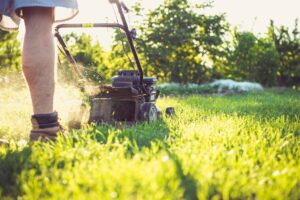 A healthy lawn requires air, water and nutrients. Thatch buildup not only blocks the uptake of these essentials but also makes it nearly impossible for new grass seed to germinate and develop. To get the most benefit from aeration, you should set your mower to 1 ½” to no more than 2”. This will keep your grass short enough to avoid impeding the aerator, while not scalping your lawn too short and doing more harm than good. If you’re only repairing small patches of your lawn, a manual thatch rake works great to pull up excess dead grass. This tool even “scuffs up” the soil in preparation for the new seed.
A healthy lawn requires air, water and nutrients. Thatch buildup not only blocks the uptake of these essentials but also makes it nearly impossible for new grass seed to germinate and develop. To get the most benefit from aeration, you should set your mower to 1 ½” to no more than 2”. This will keep your grass short enough to avoid impeding the aerator, while not scalping your lawn too short and doing more harm than good. If you’re only repairing small patches of your lawn, a manual thatch rake works great to pull up excess dead grass. This tool even “scuffs up” the soil in preparation for the new seed.
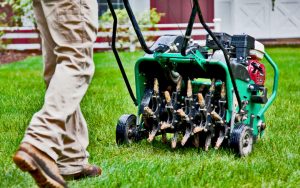 But core aeration remains the best overall approach by restoring passageways to the soil and providing the new grass seed access into the existing turf. Aerators can be rented in homeowner friendly sizes from your local rental store. Choose an aerator that extracts plugs of soil 2 to 3 inches long and deposits them on the lawn. They may look a bit unsightly, but leave them on the lawn and allow these plugs to decompose naturally. Be sure to aerate when the soil is moist, not too wet and not too dry.
But core aeration remains the best overall approach by restoring passageways to the soil and providing the new grass seed access into the existing turf. Aerators can be rented in homeowner friendly sizes from your local rental store. Choose an aerator that extracts plugs of soil 2 to 3 inches long and deposits them on the lawn. They may look a bit unsightly, but leave them on the lawn and allow these plugs to decompose naturally. Be sure to aerate when the soil is moist, not too wet and not too dry.
(Several times a year we get the question from homeowners with unsightly lawns: Is the better to rototill my yard and start all over? We strongly caution against that drastic approach. Follow our renovations steps and it will bring good results – and it is WAY easier.)
Once aeration is done, over seed
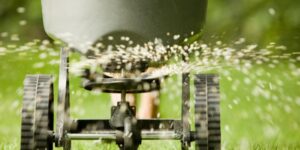 Yes, you can add your topdressing and then over-seed, but that requires the seed to be raked into the new layer of soil. Our preferred approach is to over-seed right after core aeration, then add your topdressing. This way the seed is covered and in contact with soil which is critical for seed germination. But, don’t lay down grass seed unless you’re going to topdress and begin watering immediately after. Your seed may die prematurely if you do.
Yes, you can add your topdressing and then over-seed, but that requires the seed to be raked into the new layer of soil. Our preferred approach is to over-seed right after core aeration, then add your topdressing. This way the seed is covered and in contact with soil which is critical for seed germination. But, don’t lay down grass seed unless you’re going to topdress and begin watering immediately after. Your seed may die prematurely if you do.
Broadcast your appropriate seed blend over the aerated lawn. Again, be sure to use a seed blend compatible with your existing lawn and its sun/shade conditions. Most people in northern Illinois have a bluegrass-blend lawn. So use either a high-quality bluegrass blend or a shade blend for overseeding. Grass seeds to avoid include bunch-type tall fescue (fine fescues are okay), zoysia, buffalo, rough blue and annual rye found in most Contractor’s Seed Mixes.
If most of your lawn already has thick healthy grass, overseeding will be a general upkeep task. In this case, you should use two to four pounds of seed for every 1,000 square feet of lawn. However, if your lawn has exposed areas of soil or is thin and overall unhealthy, apply four to eight pounds of seed per every 1,000 square feet. Check your spreader and use the proper setting to achieve this coverage.
Topdress your lawn
Here is where the real magic happens.
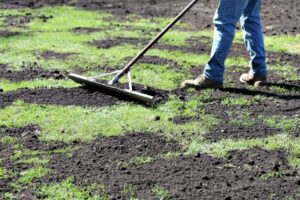 Topdressing is a fresh, richly prepared mix that you apply to the surface of your lawn for either seeding it or providing a reinforcing layer right under newly laid sod.
Topdressing is a fresh, richly prepared mix that you apply to the surface of your lawn for either seeding it or providing a reinforcing layer right under newly laid sod.
A good topdressing mix should closely resemble your existing soil’s composition. The new materials you add will form part of what’s referred to as the root zone. This is where the soil where roots grow best, so they need to blend well with the soil that’s already there.
Topdressing your lawn is most effective when it is applied in a layer of 1” or less. Remember, when renovating an existing lawn you don’t want to bury and choke out any existing grass. So be sure you can still see the tops of the existing grass as you spread your layer of topdressing.
When you add topdressing for the lawn, you help:
- replenish lost or consumed nutrients by adding organic matter to the topsoil
- reduce the need for fertilizer as a result of the organic nutrients
- improve air circulation for grass and plant roots
- enhances soil structure for growth
- contribute to greater water retention (the topdressing blocks and slows evaporation)
- make the top grass layer softer, thicker and more bouncy
The actual application of the topdressing can be done several different ways. A mechanical topdressing machine makes the job quick and easy. Finding a topdressing machine at a rental outlet that delivers might be difficult as the machine is too large for anything but a truck or trailer with a loading ramp. However, there are several other homeowner-friendly options:
![]() Option One:
Option One:
- Load you wheelbarrow from the pile of delivered material
- Using your shovel, throw / broadcast the topdressing onto the lawn. Visually, it will appear that you’re making the lawn look “dirty”. What you’re trying to achieve is that consistent ½” layer of material over the entire lawn.
Option Two:![]()
- Load you wheelbarrow from the pile of delivered material
- Dump small to medium sized mounds of material strategically around the yard
- Use a tine, leaf, landscape rake, lawn leveling rake or even a push broom to spread the topdressing to your desired ½” depth. (After you create your first few mounds, spread out the material so you get a better idea of how big and how far apart the piles will need to be.)
So what is the best Topdressing Mix for lawns?
Option one: 50/50 Topdressing
If you’ve ever wondered how and why grass on golf courses is so rich and green, topdressing with sand is a major reason. Sand is a great asset because it spreads simply and levels a surface easily. It also enhances soil structure and increases root-zone porosity to support deep roots with good infiltration of water and air.
Where black dirt will dry out, a 50/50 sand and topsoil topdressing will keep the soil moist and loose. All of our soil blends including our Topdressing mix are mechanically combined twice. Then they are mechanically blended twice for a silky-smooth, easy to spread blend. When using our 50/50 Topdressing Mix, we recommend introducing a slow-release starter fertilizer over the entire area right before you begin your watering routine.
Option Two: Lawn Repair Mix
 When you’re looking to renovate and repair your lawn, our Lawn Repair Mix is just what you’re looking for. Our Lawn Repair Mix blends the 3 top beneficial products your lawn needs most – and in the optimal percentages: 50% topsoil, 25% fine sand and 25 % Purple Cow Classic compost. (Purple Cow Classic Compost is 100% plant based finely screened, manure, weed seed and pathogen free.) It can be used as an effective topdressing for overseeding or as a stand-alone topdressing mix (think natural fertilizer). Either way your lawn will see improvement.
When you’re looking to renovate and repair your lawn, our Lawn Repair Mix is just what you’re looking for. Our Lawn Repair Mix blends the 3 top beneficial products your lawn needs most – and in the optimal percentages: 50% topsoil, 25% fine sand and 25 % Purple Cow Classic compost. (Purple Cow Classic Compost is 100% plant based finely screened, manure, weed seed and pathogen free.) It can be used as an effective topdressing for overseeding or as a stand-alone topdressing mix (think natural fertilizer). Either way your lawn will see improvement.
After applying the topdressing – add water.
After all the soil preparation has been completed, you need to water very lightly but frequently until the seed germinates. Usually, this means wetting down the seed once or twice a day. Do not let the seed dry out. After about two weeks, water deeply (about 1”) once a week to encourage strong, deep rooting. Some grasses like the fine fescue and rye will appear in 5-7 days. Bluegrass seeds take longer – 10 to 14 days, so be patient and diligent.
Prime overseeding and lawn renovation time is late August until mid-September. Your grass will require enough time after germinating to mature and thicken up before the cold weather sets in. You’re aiming for the grass to grow tall enough to require at least two mows before the end of the normal growing season. Hand pull any weeds. Don’t apply any herbicides until lawn has been mowed 2-3 times.
You don’t need to overseed every year. Rather, concentrate on good regular care and maintenance practices. That will help maintain the health of your lawn all season long. By following these few steps this Fall, you can look forward to a rich, green and healthy lawn next season. Call or stop by Tim Wallace Landscape Supply today and talk with our friendly and knowledgeable staff about your fall lawn renovation.
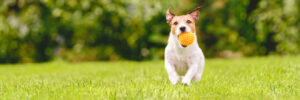


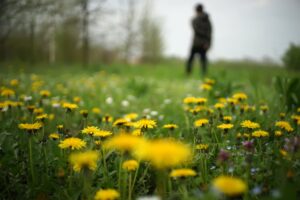 Has the grass turn “rusty” from fungus?
Has the grass turn “rusty” from fungus?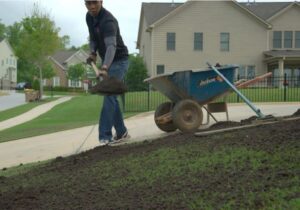 Option One:
Option One: